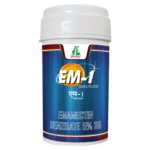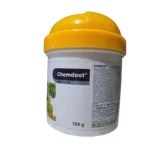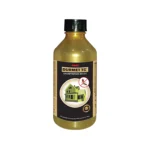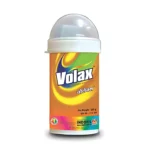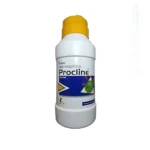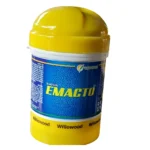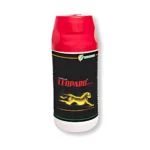Acid Lime Pests
Bark Borer
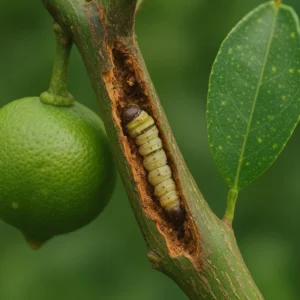
Symptoms
- Frass and Sawdust: One of the earliest signs of infestation is the presence of frass (insect excrement) and fine sawdust-like material on the bark or at the base of the tree. This material is expelled from the tunnels created by the larvae.
- Gum Exudation: Trees may ooze sap or gum around the entry points of the borers as a defense response. This sticky gum may mix with frass, forming hardened lumps on the bark.
- Wilting and Yellowing Leaves: As the larvae damage the vascular system, leaves may start to yellow, wilt, or drop prematurely due to disrupted nutrient and water flow.
- Branch Dieback: Severe infestations can lead to branch dieback and eventually tree death if the borer damage girdles the trunk or main branches.
Other Signs:
- Tunnels Under Bark: Upon peeling back the bark, winding galleries or tunnels are visible, often packed with frass and sawdust.
- Weakening and Breakage: Over time, the structural integrity of the tree may weaken, making it susceptible to breaking or falling over.
Identification
Adult Borers:
- Appearance: Adult citrus bark borers are typically small to medium-sized beetles or moths, depending on the species. For example, the adult of the citrus bark borer (Indarbela quadrinotata) is a moth that is brownish with light patches and has a wingspan of about 25-30 mm.
- Behavior: Adults do not feed on the tree itself; instead, they lay eggs on the bark or in crevices of the tree.
Larvae (Grubs or Caterpillars):
- Appearance: The larvae of bark borers are legless, creamy-white grubs or caterpillars with a dark head capsule. They can range from a few millimeters to a couple of centimeters in length, depending on the species.
- Behavior: The larvae bore into the bark and feed on the cambium layer (the living tissue just beneath the bark), creating tunnels as they feed. This boring disrupts the flow of nutrients and water within the tree, weakening it.
Management
- Systemic Insecticides: Apply systemic insecticides like Imidacloprid or Emamectin benzoate to target larvae feeding under the bark. These insecticides are absorbed by the tree and are effective against borers when applied as a trunk drench or injection. Ensure to follow label instructions and safety guidelines.
- Direct Injection or Application: Insecticides can be directly injected into borer tunnels or applied to the bark surface to target larvae. This method can be effective but requires careful application to avoid further damage to the tree.
- Preventive Sprays: Apply contact insecticides to the bark to prevent egg-laying by adult borers. Products containing Chlorpyrifos or Carbaryl can be used for this purpose.
- Mechanical Removal: For minor infestations, you can manually remove the larvae by probing into the galleries with a thin wire or knife. This should be done carefully to avoid further damage to the tree.
- Tree Wraps or Barriers: Wrapping tree trunks with fine mesh or other protective barriers can help prevent adult borers from laying eggs on the bark.
|
Insecticide |
Dosage |
|---|---|
|
0.5 gm/lit |
|
|
0.5 ml/lit |
|
|
1.5 ml/lit |
₹448
Select options
This product has multiple variants. The options may be chosen on the product page
₹499
Select options
This product has multiple variants. The options may be chosen on the product page
₹212
Select options
This product has multiple variants. The options may be chosen on the product page
₹650
Select options
This product has multiple variants. The options may be chosen on the product page
₹219
Select options
This product has multiple variants. The options may be chosen on the product page
₹399
Select options
This product has multiple variants. The options may be chosen on the product page
₹899
Select options
This product has multiple variants. The options may be chosen on the product page
